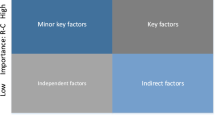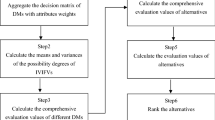Abstract
Nuclear safeguards evaluation (NSE) is to verify that a State is living up to its international undertakings not to use nuclear programs for nuclear weapons purposes. The main issue in NSE is on the aggregation of expert evaluations for numerous indicators to make a final decision about the State’s nuclear activity. Fuzzy multiple attribute decision making (FMADM) methods are capable of dealing with such an issue. In this study, we propose a new FMADM methodology to solve the NSE problem. To this end, we investigate the applicability of four basic FMADM methods, namely a simple additive weighting method, a TOPSIS method, a linguistic method, and a non-compensatory method, to the NSE issue. As a result of the assessment of the basic methods, we propose a new FMADM methodology based on a new aggregation operator in which a cumulative belief structure is used to represent the expert evaluations. The basic methods and the proposed method as well are applied to an example from the literature for illustration purposes.
Similar content being viewed by others
References
Korhonen P., Moskowitz H., Wallenius J.: Multiple criteria decision support—a review. Eur. J. Oper. Res. 63, 361–375 (1992)
Dyer J.S., Fishburn P.C., Steuer R.E., Wallenius J., Zionts S.: Multiple criteria decision making, multiattribute utility theory: the next ten years. Manag. Sci. 38(5), 645–654 (1992)
Pardalos, P.M., Siskos, Y., Zopounidis, C. (eds): Advances in multicriteria analysis. Kluwer Academic Publishers, Dordrecht (1995)
Yoon K., Hwang C.: Multiple attribute decision making. Springer, Heidelberg (1995)
Chen S., Hwang C.: Fuzzy multiple attribute decision making: methods and applications. Lecture notes in economics and mathematical systems. Springer, Berlin (1992)
Stewart T.J.: A critical survey of the status of multiple criteria decision making theory and practice. OMEGA 20, 569–586 (1992)
Esogbue A.O.: Dynamic programming approaches. In: Pardalos, P.M., Resende, M. (eds) Handbook of Applied Optimization, pp. 78–103. Oxford University Press, New York (2002)
Zadeh L.A.: Fuzzy sets. Inf. Cont. 8, 338–353 (1965)
Dubois D., Prade H., Testemale C.: Weighted fuzzy pattern matching. Fuzzy Sets Syst. 28(3), 313–331 (1988)
Bellman R.E., Zadeh L.A.: Decision-making in a fuzzy environment. Manag. Sci. 17(4), B141–B164 (1970)
Yager R.R.: Fuzzy decision making including unequal objectives. Fuzzy Sets Syst. 1(2), 87–95 (1978)
Deng H., Yeh C.-H.: Simulation-based evaluation of defuzzification-based approaches to fuzzy multiattribute decision making. IEEE Trans. Syst. Man Cybern A Syst. Hum. 36(5), 968–977 (2006)
Baas S.M., Kwakernaak H.: Rating and ranking of multiple-aspect alternatives using fuzzy sets. Automatica 13, 47–58 (1977)
Dubois, D., Prade, H.: The use of fuzzy numbers in decision analysis. In: Gupta, M.M., Sanchez, E. (eds.) Fuzzy Information and Decision Processes, pp. 309–321. North-Holland, (1982)
Chou S.-Y., Chang Y.-H., Shen C.Y.: A fuzzy simple additive weighting system under group decision-making for facility location selection with objective/subjective attributes. Eur. J. Oper. Res. 189(1), 132–145 (2008)
Hwang C.L., Yoon K.: Multiple Attribute Decision Making: Methods and Applications. Springer, New York (1981)
Negi, D.S.: Fuzzy Analysis and Optimization, Ph. D. Thesis, Department of Industrial Engineering, Kansas State University (1989)
Wu W.-Y., Lin C., Kung J.-Y., Lind C.-T.: A new fuzzy TOPSIS for fuzzy MADM problems under group decisions. J. Intell. Fuzzy Syst. 18, 109–115 (2007)
Chen T.-Y., Tsao C.-Y.: The interval-valued fuzzy TOPSIS method and experimental analysis. Fuzzy Sets Syst. 159(11), 1410–1428 (2008)
Chen C.T.: Extensions of the TOPSIS for group decision-making under fuzzy environment. Fuzzy Sets Syst. 114(1), 1–9 (2000)
Wang Y.J., Lee H.S.: Generalizing TOPSIS for fuzzy multiple-criteria group decision-making. Comput. Math. Appl. 53(11), 1762–1772 (2007)
Saaty T.L.: A scaling method for priorities in hierarchical structures. J. Math. Psychol. 15(3), 234–281 (1977)
Laarhoven P.J.M., Pedrycz W.: A fuzzy extension of Saaty’s priority theory. Fuzzy Sets Syst. 11(3), 229–241 (1983)
Buckley J.J., Feuring T., Hayashi Y.: Fuzzy hierarchical analysis revisited. Eur. J. Oper. Res. 129, 48–64 (2001)
Kahraman, C., Cebeci U., Ruan D.: Multi-attribute comparison of catering service companies using fuzzy AHP: The case of Turkey. Int. J. Prod. Econ. 87(2), 171–184 (2004)
Chan F.T.S., Kumar N.: Global supplier development considering risk factors using fuzzy extended AHP-based approach. OMEGA 35(4), 417–431 (2007)
Roy B.: Classement et choix en présence de points de vue multiples (la méthode ELECTRE). RIRO 8, 57–75 (1968) (in French)
Brans J.P., Vincke P.: A preference ranking organization method: the PROMETHEE method for MCDM. Manag. Sci. 31(6), 647–656 (1985)
Figueira J.R., Greco S., Roy R., Słowinski R.: ELECTRE methods: main features and recent developments. In: Zopounidis, C., Pardalos, P.M. (eds) Handbook of Multicriteria Analysis, Applied Optimization, Vol. 103, pp. 51–90. Springer, Berlin (2010)
F., F.: A new perspective for assessing the sustainability of countries. J. Trans. Manag. 12(4), 3–32 (2008)
Aouam T., Chang S.I., Lee E.S.: Fuzzy MADM: an outranking method. Eur. J. Oper. Res. 145(2), 317–328 (2003)
Fernandez E., Lopez E., Bernal S., Coello C.A.C., Navarro J.: Evolutionary multiobjective optimization using an outranking-based dominance generalization. Comput. Oper. Res. 37(2), 390–395 (2010)
Herrera F., Martínez L.: A 2-tuple fuzzy linguistic representation model for computing with words. IEEE Trans. Fuzzy Syst. 8(6), 746–752 (2000)
Martinez L., Liu J., Ruan D., Yang J.-B.: Dealing with heterogeneous information in engineering evaluation processes. Inf. Sci. 177, 1533–1542 (2007)
Wu Z., Chen Y.: The maximizing deviation method for group multiple attribute decision making under linguistic environment. Fuzzy Sets Syst. 158, 1608–1617 (2007)
Fan Z.-P., Feng B.: A multiple attributes decision making method using individual and collaborative attribute data in a fuzzy environment. Inf. Sci. 179(20), 3603–3618 (2009)
Kabak, Ö., Ruan, D.: A cumulative belief degree-based approach for missing values in nuclear safeguards evaluation, IEEE Trans. Knowl. Data Eng., (2010) IEEE computer Society Digital Library. IEEE Computer Society, http://doi.ieeecomputersociety.org/10.1109/TKDE.2010.60
IAEA: Physical Model, IAEA Department of Safeguards, SRT-314 (1999)
Liu J., Ruan D., Carchon R.: Synthesis and evaluation analysis of the indicator information in nuclear safeguards applications by computing with words. Int. J. Appl. Math. Comput. Sci. 12(3), 229–462 (2002)
Liu J., Ruan D., Wang H., Martinez L.: Improving nuclear safeguards evaluation through enhanced belief rule-based inference methodology. Int. J. Nucl. Knowl. Manag. 3(3), 312–339 (2009)
Yager R.R.: On ordered weighted averaging aggregation operators in multicriteria decision-making. IEEE Trans. Syst. Man Cybern. 18(1), 183–190 (1988)
Yager R.R.: On the inclusion of importances in OWA aggregations. In: Yager, R.R., Kacprzyk, J. (eds) The Ordered Weighted Averaging Operators: Theory and Applications, pp. 41–59. Kluwer, Boston (1997)
Yang J.-B.: Rule and utility based evidential reasoning approach for multiattribute decision analysis under uncertainties. Eur. J. Oper. Res. 131, 31–61 (2001)
Yang J.-B., Sen P.: A general multi-level evaluation process for hybrid MADM with uncertainty. IEEE Trans. Syst. Man Cybern. 24(10), 1458–1473 (1994)
Yang J.-B., Singh M.G.: An evidential reasoning approach for multiple attribute decision making with uncertainty. IEEE Trans. syst. Man Cybern. 24(1), 1–18 (1994)
Xu Z.: An overview of methods for determining OWA weights. Int. J. Intell. Syst. 20, 843–865 (2005)
Author information
Authors and Affiliations
Corresponding author
Rights and permissions
About this article
Cite this article
Kabak, Ö., Ruan, D. A comparison study of fuzzy MADM methods in nuclear safeguards evaluation. J Glob Optim 51, 209–226 (2011). https://doi.org/10.1007/s10898-010-9601-1
Received:
Accepted:
Published:
Issue Date:
DOI: https://doi.org/10.1007/s10898-010-9601-1




